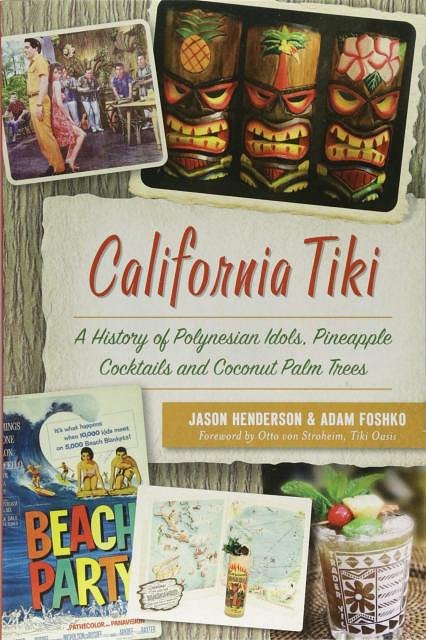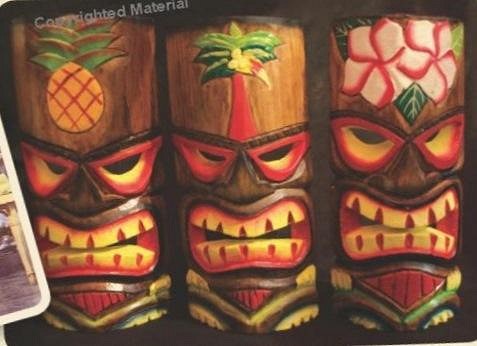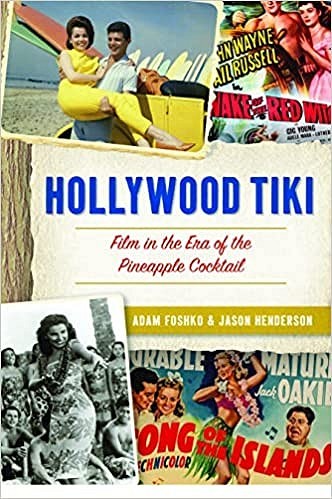Tiki Central / General Tiki
"California Tiki" by Jason Henderson & Adam Foshko
Pages: 1 14 replies
|
H

Hamo
Posted
posted
on
Thu, Oct 18, 2018 6:44 PM
I recently discovered California Tiki: A History of Polynesian Idols, Pineapple Cocktails and Coconut Palm Trees by Jason Henderson & Adam Foshko, with a forward by Otto. Looks like it was just published in July. Anybody here read it yet?
|
|
B
bigbrotiki
Posted
posted
on
Fri, Oct 19, 2018 7:31 AM
I read into it. It is well written, by some nice guys, writers/bloggers that got the job to write a book about Tiki from the publisher. So it's like they kind of discovered it...yesterday. Which is not per se bad, Tiki can benefit from fresh, new perspectives. Yet while the book's subtitle promises "A History of Polynesian Idols, Pineapple Cocktails and Coconut Palm Trees", there is very little about the first subject (the idols), and more about the generic tropical cliches (pineapple cocktails and coconut palm trees) that surround Tiki in it. Quote: "When we first set out to explore Tiki Culture, we had only the faintest idea of what we were getting into....we knew that Tiki was a culture of palm trees and vaguely Hawaiian-sounding music, of Tiki torches and Mai Tais..." It would have been nice if along the way they would have found out more about TIKI, the title character. They write about finding the SPIRIT of Tiki, ESCAPISM, and list a number of pop culture trends of the period. Elvis, surfing, Gidget - all parts of mid-century pop culture that we love, and which have a few elements of Tiki to them...but ARE not Tiki by themselves. A good litmus test is to always ask yourself "Was this called "Tiki" in its day?" If not, why would it be so today. Imagine what the old timers would say if you would tell them Gidget was "Tiki". I know, I know, it is bad style for the authority on a subject to bitch and moan about the publishing efforts of others, I should cloak myself in humble silence and let it pass. But I have vowed to defend the integrity of Tiki until my dying day. What people often don't realize is that with the attempt to make Tiki all-inclusive, with the hot-rods and fezzes and burlesque girls, with "Tiki" cocktail bars that serve only the drinks but have no other Tiki elements, they are watering down the uniqueness of the style, making it less special, bit by bit. Its uniqueness is that it was a form of 20th Century idolatry, carved out by American artists and entrepreneurs, and that Tiki was their god of recreation. They might have not been aware of it in their time, but that's how it presented itself to me when I came upon it, and that is what inspired me to sing its gospel, which in turn inspired countless new artists and entrepreneurs. It is wonderful to see so many "churches" of Tiki spring up, but I do reserve the right that if they call themselves "Tiki" to remind them of the core religion. And for (Tiki)god's sake, if you title a book CALIFORNIA Tiki, put a carving from a California artist or from Oceanic Arts on the cover, and not some generic Asian import party city Tikis - with pineapples and palm trees on their foreheads. Oh, P.S.: Otto's foreword is nice and concise! :) [ Edited by: bigbrotiki 2018-10-19 07:40 ] |
|
T
TheBigT
Posted
posted
on
Fri, Oct 19, 2018 10:57 AM
Just finished reading all but the last two pages last night. Found it a little thin on substance and a bit of a miss on the subject. There's the prerequisite "Intro To Tiki" chapter and then chapters on Tiki in films, TV, music, and the demise and resurgance of Tiki. Along the way example photos are interspersed, such plastic tiki tumblers, colorful Indonesian tiki masks, movie posters, and album covers. Was confused early on by the Chapter 2 essay, The Man in the Gray Flannel Suit. The rest of the book read as a series of synopses on various movies and albums. Is this what Tiki means to newcomers looking into the subject? Surf music, beach party movies, Fantasy Island, the Brady Bunch?! I didn't encounter any of these things on a whirlwind tour of the Bali Hai, Humphrey's Half Moon Inn, False Idol, Tonga Hut, the Reef and so forth last year. All of which were my first exposure to "California Tiki". The authors seem capable enough. It's the research, I think, that wasn't well baked. The $23.99 paperback price deserved better I think. |
|
M
MadDogMike
Posted
posted
on
Fri, Oct 19, 2018 12:54 PM
Right? :lol: |
|
B
bigbrotiki
Posted
posted
on
Fri, Oct 19, 2018 1:02 PM
If it would a magazine article, or a blog series, it would be one thing. But a BOOK (not 160 as advertised on Amazon, but 118 pages) represents something of authority and importance. There are other people with more information and material that would love to have a book published about their passion. This tome will ad to the misinformation and muddling down of the concept of Tiki that is out there already - because it's a BOOK, so it must be true! |
|
H

Hamo
Posted
posted
on
Mon, Oct 22, 2018 8:55 PM
Well, even so, I couldn't have asked for a better source to answer my question. Those tikis on the cover and the "pineapple cocktails" phrase in the subtitle did raise my suspicions. And BigT confirms my hunch from the table of contents that it appeared to be light on the "California" aspect of tiki culture. I think I'll just remain content to The Book of Tiki, Tiki Modern, Tiki Pop, and The Art of Tiki.... |
|
T
tikiskip
Posted
posted
on
Tue, Oct 23, 2018 6:09 AM
I can remember when there was a girl writing a book on the Kahiki here, people shut her out and did not want to help her, so I would guess it could be hard on a tiki outsider to do this. And there was two other people that contacted me as they too were writing a book on the Kahiki, everybody told me "you don't know who they are why would you help them" Well I did help them and even the first girl as little as she asked. But the other two took me on a fun journey and we interviewed some people, we got the first stuff from the Kahiki warehouse before the auction. None of these people wrote a book, Greg and Melissa's would have been a good one but they broke up the stuff went who knows where but it was still fun and I remember all the details so there is that. And I got some cool Kahiki stuff. But I wonder how these guys got it so wrong when they at least were in contact with Otto? And there are no reviews of this book on Amazon, It may help to post a few "this book misses the mark" type reviews so others will look for or at least know there is more to the tiki story. It is good? I guess that they are still willing to take on and print books on the tiki subject. I just wish that more people that are going to sit across the table at Thanksgiving with the people that were there at the beginning of the tiki boom would write a book as they should have the inside track to the good stuff. Time is running out as the people that were there are losing memories of those days. My wife wanted me to do a Kahiki book but I can't spell or form a proper sentence. When I asked Lee Henrys wife --- ---- ---- ------ -- - ---? I could actually see him kick his wife under the table as she started to answer me, stuff like that. |
|
PP

Prikli Pear
Posted
posted
on
Tue, Oct 23, 2018 8:42 AM
History Press is my publisher. I have very few complaints, because they really went out of their way to make my Chicken Ranch book the best it could be, and made allowances from their normal publication parameters. I was like Sven, in a way, because I came to them with years of research, collected artifacts and a complete book ready for publication. History Press pays no advance. The royalty rate is okay, but they base it on the wholesale price (which can vary) rather than the cover price. Their production deadlines are tight. Their book lengths are relatively restrictive. If these authors sort of fell into doing this book, I can guarantee they didn't have enough time to do proper research into the subject. Granted, they probably shouldn't have pitched a book on the topic if they didn't know what they were getting into, but they likely didn't know how much they didn't know, if that makes sense. An authoritative book on California tiki would take years to research, with countless hours of interviews, and cost significant out-of-pocket expenses to do right. Heck, the same could be said for a book on Texas tiki history, and we all know Texas never had 1/10th the tiki culture California had. I'll likely get it, regardless. But it's not a priority. |
|
PP

Prikli Pear
Posted
posted
on
Tue, Oct 23, 2018 8:49 AM
Also, HP's business model is to publish hyper-local histories and special interest books in very small press runs. First edition of California Tiki is a thousand copies or less. If 500 copies sell, HP makes a profit. If a thousand sell, they go back to the press and put out another thousand. Most of their authors are local historians and enthusiasts, so while their editors go through the book and question anything that stands out as an odd claim, it's not like the material is peer-reviewed by a panel of experts for accuracy. As others have said, that falls to thoughtful reviews online, be it via Amazon, Goodreads or elsewhere. |
|
T
tikiskip
Posted
posted
on
Tue, Oct 23, 2018 9:29 AM
"HP's business model is to publish hyper-local histories and special interest books in very small press runs" So they figure that each "author" has at least 100 friends and family that will buy the book and all they need is 400 others to buy the book to make money. |
|
PP

Prikli Pear
Posted
posted
on
Tue, Oct 23, 2018 11:48 AM
To an extent, but HP (bought a couple of years ago by Arcadia) is a legit publisher. They have national distribution deals and have had a few national bestsellers. They're more concerned with active historical societies and point-of-sale tourist attractions. A true vanity press offers no advance, charges the author outrageous fees to print the books, then makes the author sell to friends and family. A different model doesn't charge the author anything upfront, but publishes massive numbers of would-be authors as ebooks (no materials cost) with little editorial oversight, then gets the author to shill those "copies" for a miniscule royalty. Oh, and the "publisher" usually grabs every right in existence, so if the book becomes successful despite the odds, they can profit more by selling the reprint/movie/merchandising rights and not sharing with the author. It may not sound like much, but that national distribution is a huge deal. HP has some turkeys in their backlist, but there are also some pretty cool titles on subject matter that wouldn't likely interest larger publishers. Texas Shipwrecks, for one, is fascinating. In the end, they're looking for books and topics that sell. |
|
T
tikiskip
Posted
posted
on
Tue, Oct 23, 2018 4:52 PM
I just wish these books were as big and vibrant as the places they are about. The info is still great to read but it's all about the eye candy. |
|
H

Hamo
Posted
posted
on
Wed, Oct 24, 2018 10:28 PM
I agree, Skip. As great as the Kahiki book is, the place definitely deserves a lavish, Technicolor treatment, like the BOT or Swanky’s Mai Kai book. |
|
H

Hamo
Posted
posted
on
Mon, Jun 27, 2022 8:21 PM
I've learned from a Classic Hollywood blog I regularly read that these authors have another title coming out in August: Hollywood Tiki: Film in the Era of the Pineapple Cocktail https://www.amazon.com/gp/product/146714990X/
I'm not particularly hopeful that is will be any more representative of tiki culture than the original title. |
|
T
tikiskip
Posted
posted
on
Tue, Jun 28, 2022 8:00 AM
These books better have some great information in them as they are small and have these small black and white photos in them. I would rather have a huge book with color photos and no text. These books are just a way for a guy or girl to say look at me I am an author. Even John boy on the Waltons had to find out the hard way that this was just a way for the publisher to get an author to sell books for them. There needs to be a huge full color Kahiki book put out. But then even a small black and white pamphlet on the Kahiki would sell in Ohio, and they know that. |
Pages: 1 14 replies



